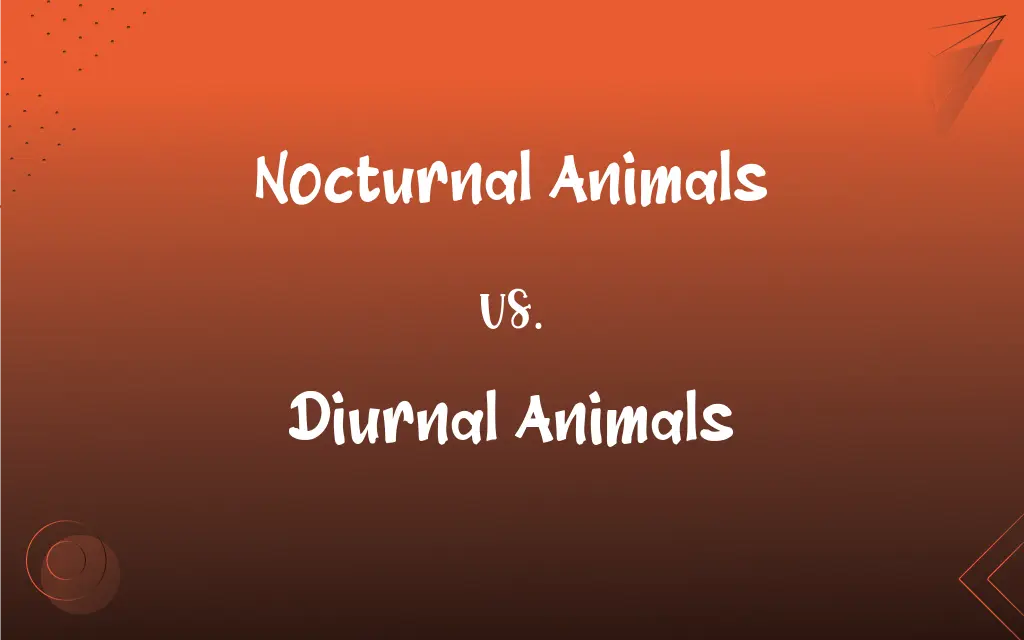Nocturnal Animals vs. Diurnal Animals: What's the Difference?
Edited by Aimie Carlson || By Janet White || Published on March 3, 2024
Nocturnal animals are active at night, while diurnal animals are active during the day.

Key Differences
Nocturnal animals, such as owls and bats, have adapted to life in the dark. These adaptations might include enhanced hearing, smell, and specially adapted eyesight. Nocturnal species often exhibit behaviors and physical characteristics that minimize water loss and conserve energy, crucial in environments where daytime temperatures can be extreme. Diurnal animals, like humans and many birds, are active during daylight hours. These animals have evolved to take advantage of the light for hunting, foraging, and avoiding predators. Diurnal species often possess keen vision, which is important for identifying predators and prey in the light.
The distinction between nocturnal and diurnal animals is not just a matter of preference but a complex adaptation to their respective environments. Nocturnal animals often have a slower metabolism, which helps in conserving energy during the day when they rest. In contrast, diurnal animals might have a higher metabolism to support their daytime activities.
In ecosystems, nocturnal and diurnal animals play unique roles. Nocturnal animals can avoid daytime competition and predation by being active at night, while diurnal animals can use the sunlight to warm their bodies and aid in vision. This temporal separation helps in reducing competition for food and resources.
The differences between nocturnal and diurnal animals reflect a fascinating range of adaptations to their environments. These adaptations allow them to thrive in their specific niches, contributing to the biodiversity and balance of ecosystems around the world.
Comparison Chart
Active Period
Night
Day
ADVERTISEMENT
Adaptations
Enhanced hearing, smell, night vision
Keen daylight vision, higher metabolism
Lifestyle Benefits
Avoid daytime heat, competition, predation
Use sunlight for warmth, better visibility
Metabolism
Generally slower
Generally higher
Example Species
Owls, bats
Humans, eagles
Nocturnal Animals and Diurnal Animals Definitions
Nocturnal Animals
Nocturnal animals are species that are active during the night.
Owls hunt under the cover of darkness, typical of nocturnal animals.
ADVERTISEMENT
Diurnal Animals
They typically have well-developed vision suited for daylight.
The sharp eyesight of eagles is an adaptation of diurnal animals.
Nocturnal Animals
Nocturnal species can thrive in environments where daytime temperatures are extreme.
Desert rodents are nocturnal animals, avoiding the daytime heat.
Diurnal Animals
Diurnal animals are species that are active during daylight hours.
Squirrels are diurnal animals, often seen foraging during the day.
Nocturnal Animals
These animals usually rest or remain inactive during daylight.
Nocturnal animals like possums retreat to their dens at dawn.
Diurnal Animals
Diurnal species can include both predators and prey animals.
Lions, though sometimes active at night, are primarily diurnal animals.
Nocturnal Animals
They often possess adaptations like acute hearing and night vision.
The silent flight of bats showcases the stealth of nocturnal animals.
Diurnal Animals
Their active period aligns with the availability of visual cues.
Diurnal animals like butterflies rely on daylight to navigate.
Nocturnal Animals
Their lifestyle helps them evade predators and competition for food.
Nocturnal animals such as foxes forage at night to avoid competition.
Diurnal Animals
These animals use sunlight to regulate their body temperature.
Lizards bask in the sun, demonstrating the behavior of diurnal animals.
FAQs
Can an animal be both nocturnal and diurnal?
Some animals, known as crepuscular, are active during twilight, overlapping both periods.
What makes an animal diurnal?
Diurnal animals are those that are primarily active during daylight hours.
Why have nocturnal animals evolved to be active at night?
To avoid daytime heat, competition, and predators.
Do nocturnal animals have better hearing than diurnal animals?
Many nocturnal animals have developed enhanced hearing to navigate and hunt in the dark.
Are there any birds that are nocturnal?
Yes, some bird species like owls are nocturnal.
Do diurnal animals sleep at night?
Yes, most diurnal animals have a sleep cycle that includes nighttime rest.
How do nocturnal animals avoid predators?
They use darkness as cover, and their adaptations help them detect threats.
Is being diurnal an advantage for predators?
It can be, as daylight provides better visibility for spotting prey.
What defines an animal as nocturnal?
Nocturnal animals are those that are primarily active during the night.
Can nocturnal animals see in complete darkness?
No, but they have adaptations that significantly improve their vision in low-light conditions.
What adaptations do diurnal animals have?
They often have adaptations like keen daylight vision and a higher metabolism.
Why are some animals strictly nocturnal?
It could be due to evolutionary traits that favored night activity for survival.
What challenges do diurnal animals face?
They may deal with higher competition for food and more direct exposure to predators.
How do diurnal animals benefit from being active during the day?
They can use sunlight for warmth and have better visibility for hunting or foraging.
How do nocturnal animals communicate?
Through sounds, scents, or low-light visual signals.
How do diurnal and nocturnal animals coexist?
Their different active periods reduce direct competition and allow for a more balanced ecosystem.
Are all bats nocturnal?
Most bats are nocturnal, though there are exceptions.
What role do nocturnal animals play in the ecosystem?
They help control pest populations, pollinate plants, and are part of the food web.
Do diurnal animals have any predators?
Yes, they can be preyed upon by other diurnal predators or nocturnal predators active at dawn or dusk.
Can nocturnal animals be active during the day?
Some might be active during the day, but it's less common and usually for specific reasons like food scarcity.
About Author
Written by
Janet WhiteJanet White has been an esteemed writer and blogger for Difference Wiki. Holding a Master's degree in Science and Medical Journalism from the prestigious Boston University, she has consistently demonstrated her expertise and passion for her field. When she's not immersed in her work, Janet relishes her time exercising, delving into a good book, and cherishing moments with friends and family.
Edited by
Aimie CarlsonAimie Carlson, holding a master's degree in English literature, is a fervent English language enthusiast. She lends her writing talents to Difference Wiki, a prominent website that specializes in comparisons, offering readers insightful analyses that both captivate and inform.







































































